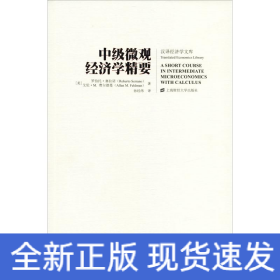
中级微观经济学精要(英文版)
全新正版 极速发货
¥ 38.73 5.0折 ¥ 78 全新
库存4件
广东广州
认证卖家担保交易快速发货售后保障
作者(美)罗伯托?塞拉诺//艾伦?M.费尔德曼 著作 著
出版社上海财经大学出版社
ISBN9787564222901
出版时间2015-11
装帧平装
开本其他
定价78元
货号1201253249
上书时间2024-11-23
- 最新上架
商品详情
- 品相描述:全新
- 商品描述
-
目录
Preface
1 Introduction
Part Ⅰ Theory of the Consumer
2 Preferences and Utility
2.1 Introduction
2.2 The Consumers Preference Relation
2.3 The Marginal Rate of Substitution
2.4 The Consumers Utility Function
2.5 Utility Functions and the Marginal Rate of Substitution
2.6 A Solved Problem
Exercises
Appendix. Differentiation of Functions
3 The Budget Constraint and the Consumers Optimal Choice
3.1 Introduction
3.2 The Standard Budget Constraint, the Budget Set, and the Budget Line
3.3 Shifts of the Budget Line
3.4 Odd Budget Constraints
3.5 Income and Consumption over Time
3.6 The Consumers Optimal Choice: Graphical Analysis
3.7 The Consumers Optimal Choice: Utility Maximization Subject to the Budget Constraint
3.8 Two Solved Problems
Exercises
Appendix. Maximization Subject to a Constraint:
The Lagrange Function Method
4 Demand Functions
4.1 Introduction
4.2 Demand as a Function of Income
4.3 Demand as a Function of Price
4.4 Demand as a Function of Price of the Other Good
4.5 Substitution and Income Effects
4.6 The Compensated Demand Curve
4.7 Elasticity
4.8 The Market Demand Curve
4.9 A Solved Problem
Exercises
5 Supply Functions for Labor and Savings
5.1 Introduction to the Supply of Labor
5.2 Choice between Consumption and Leisure
5.3 Substitution and Income Effects in Labor Supply
5.4 Other Types of Budget Constraints
5.5 Taxing the Consumers Wages
5.6 Saving and Borrowing: The Intertemporal Choice of Consumption
5.7 The Supply of Savings
5.8 A Solved Problem
Exercises
6 Welfare Economics 1: The One-Person Case
6.1 Introduction
6.2 Welfare Comparison of a Per-Unit Tax and an Equivalent Lump-Sum Tax
6.3 Rebating a Per-Unit Tax
6.4 Measuring a Change in Welfare for One Person
6.5 Measuring Welfare for Many People; A Preliminary Example
6.6 A Solved Problem
Exercises
Appendix. Revealed Preference
7 Welfare Economics 2: The Many-Person Case
7.1 Introduction
7.2 Quasilinear Preferences
7.3 Consumers Surplus
7.4 A Consumers Surplus Example with Quasilinear Preferences
7.5 Consumers Surplus
7.6 A Last Word on the Quasilinearity Assumption
7.7 A Solved Problem
Exercises
Part Ⅱ Theory of the Producer
8 Theory of the Firm 1: The Single-Input Model
8.1 Introduction
8.2 The Competitive Firms Problem, Focusing on Its Output
8.3 The Competitive Firms Problem, Focusing on Its Input
8.4 Multiple Outputs
8.5 A Solved Problem
Exercises
9 Theory of the Firm 2: The Long-Run, Multiple-Input Model
9.1 Introduction
9.2 The Production Function in the Long Run
9.3 Cost Minimization in the Long Run
9.4 Profit Maximization in the Long Run
9.5 A Solved Problem
Exercises
10 Theory of the Firm 3: The Short-Run, Multiple-Input Model
10.1 Introduction
10.2 The Production Function in the Short Run
10.3 Cost Minimization in the Short Run
10.4 Profit Maximization in the Short Run
10.5 A Solved Problem
Exercises
Part Ⅲ Partial Equilibrium Analysis: Market Structure
11 Perfectly Competitive Markets
11.1 Introduction
11.2 Perfect Competition
11.3 Market/Industry Supply
11.4 Equilibrium in a Competitive Market
11.5 Competitive Equilibrium and Social Surplus Maximization
11.6 The Deadweight Loss of a Per-Unit Tax
11.7 A Solved Problem
Exercises
12 Monopoly and Monopolistic Competition
12.1 Introduction
12.2 The Classical Solution to Monopoly
12.3 Deadweight Loss from Monopoly: Comparing Monopoly and Competition
12.4 Price Discrimination
12.5 Monopolistic Competition
12.6 A Solved Problem
Exercises
13 Duopoly
13.1 Introduction
13.2 Cournot Competition
13.3 More on Dynamics
13.4 Collusion
13.5 Stackelberg Competition
13.6 Bertrand Competition
13.7 A Solved Problem
Exercises
14 Game Theory
14.1 Introduction
14.2 The Prisoners Dilemma, and the Idea of Dominant Strategy Equilibrium
14.3 Prisoners Dilemma Complications: Experimental Evidence and Repeated Games
14.4 The Battle of the Sexes, and the Idea of Nash Equilibrium
14.5 Battle of the Sexes Complications: Multiple or No Nash Equilibria, and Mixed Strategies
14.6 The Expanded Battle of the Sexes, When More Choices Make Players Worse Off
14.7 Sequential Move Games
14.8 Threats
14.9 A Solved Problem
Exercises
Part IV General Equilibrium Analysis
15 An Exchange Economy
15.1 Introduction
15.2 An Economy with Two Consumers and Two Goods
15.3 Pareto Efficiency
15.4 Competitive or Walrasian Equilibrium
15.5 The Two Fundamental Theorems of Welfare Economics
15.6 A Solved Problem
Exercises
16 A Production Economy
16.1 Introduction
16.2 A Robinson Crusoe Production Economy
16.3 Pareto Efficiency
16.4 Walrasian or Competitive Equilibrium
16.5 When There Are Two Goods, Bread and Rum
16.6 The Two Welfare Theorems Revisited
16.7 A Solved Problem
Exercises
Part V Market Failure
17 Externalities
17.1 Introduction
17.2 Examples of Externalities
17.3 The Oil Refiner and the Fish Farm
17.4 Classical Solutions to the Externality Problem: Pigou and Coase
17.5 Modern Solutions for the Externality Problem: Markets
for Pollution Rights
17.6 Modern Solutions for the Externality Problem: Cap and Trade
17.7 A Solved Problem
Exercises
18 Public Goods
18.1 Introduction
18.2 Examples of Public Goods
18.3 A Simple Model of an Economy with a Public Good
18.4 The Samuelson Optimality Condition
18.5 The Free Rider Problem and Voluntary Contribution
Mechanisms
18.6 How to Get Efficiency in Economies with Public Goods
18.7 A Solved Problem
Exercises
19 Uncertainty and Expected Utility
19.1 Introduction and Examples
19.2 Von Neumann-Morgenstern Expected Utility: Preliminaries
19.3 Von Neumann-Morgenstern Expected Utility:
Assumptions and Conclusion
19.4 Von Neumann-Morgenstern Expected Utility: Examples
19.5 A Solved Problem
Exercises
20 Uncertainty and Asymmetric Information
20.1 Introduction
20.2 When Sellers Know More Than Buyers: The Market for "Lemons"
20.3 When Buyers Know More Than Sellers: A Market for Health Insurance
20.4 When Insurance Encourages Risk Taking: Moral Hazard
20.5 The Principal-Agent Problem
20.6 What Should Be Done about Market Failures Caused by Asymmetric Information
20.7 A Solved Problem
Exercises
Index
内容摘要
本书在中级层次上,以微积分为工具,简要介绍了微观经济学的核心概念。作者首先介绍了消费者理论,讨论了偏好和效用、预算约束、消费者的最优选择、需要及消费者的劳动力供给与储蓄决策等。
相关推荐
— 没有更多了 —





















以下为对购买帮助不大的评价